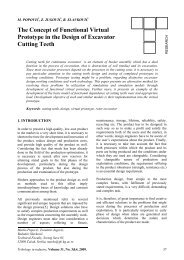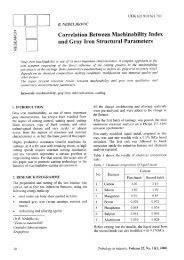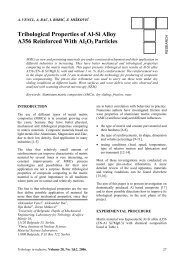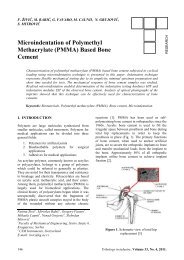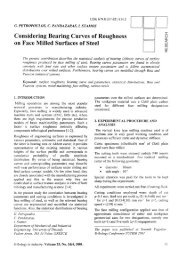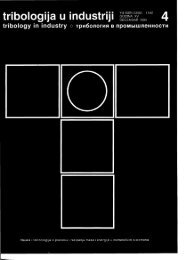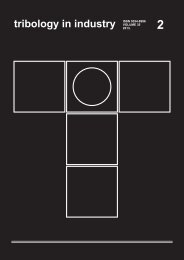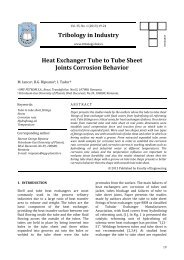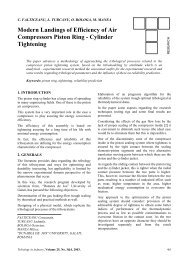Tribological Behavior of Thermal Spray Coatings, Deposited by ...
Tribological Behavior of Thermal Spray Coatings, Deposited by ...
Tribological Behavior of Thermal Spray Coatings, Deposited by ...
Create successful ePaper yourself
Turn your PDF publications into a flip-book with our unique Google optimized e-Paper software.
A. Lanzutti at al., Tribology in Industry Vol. 35, No. 2 (2013) 113‐122The COF acquired for the Ni/SiC electrodeposits islower compared to the pure Ni electrodeposit. Thiscould be related to both different mechanicalproperties <strong>of</strong> the composite material respect to thepure Ni and possible interactions <strong>of</strong> SiC particleswith countermaterial that could lower the surfaceenergy and interaction <strong>of</strong> the 2 surfaces.At high temperature the COF graphs are verysimilar and this behaviour could be related to thechange <strong>of</strong> contact, compared with roomtemperature test that is between Ni oxide and theWC sphere, instead <strong>of</strong> Ni slightly oxidized and WC.4. CONCLUSIONSIn this work different type <strong>of</strong> coatings have beenanalysed deposited either <strong>by</strong> thermal spraytechniques or <strong>by</strong> electrodeposition. The coatingsdeposited <strong>by</strong> thermal spray are: NiCr (APS), WCCoCr (HVOF) and NiCr+Cr 2 O 3 (APS) . Theelectrodeposits are Ni/SiC coatings with nano‐ ormicro‐sized particles embedded in metal matrix.The analysed coatings showed differentmicrostructure that depends on both depositedmaterial and deposition technique.Regarding the wear properties, the steel substrateshowed the worst wear resistance at both roomtemperature and 300 °C. This behaviour is relatedto the low mechanical properties <strong>of</strong> this steel thatare decreasing as the temperature increases.All the tested metal matrix coatings underwenttriboxidation that was increased at hightemperature test. The triboxidation behaviourdepends on metal oxidation resistance. The ceramiccoating was subjected to an intensive materialdetachment, caused mainly <strong>by</strong> the highinterconnected porosity <strong>of</strong> the thermal sprayedcoating. The detachment increased in function <strong>of</strong>temperature because the ceramic oxide changedphase under the hertzian loads. For all the metalmatrix coatings was present a third body abrasioncaused mainly <strong>by</strong> both oxide descaling and ceramicreinforcement detachment from the metal matrix.Observing the wear rates, the WC CoCr coatingshowed the highest wear resistance at bothroom temperature and 300 °C. This behaviour isrelated to the microstructure <strong>of</strong> the deposit: thereinforcing particles (WC) give high hardnessalso at high temperature and the metal matrix(CoCr) increases the toughness <strong>of</strong> the coatingand acts as binder for the reinforcing particles.The electrodeposits Ni/nSiC showed a wearbehaviour that is comparable with the WC CoCrone. For the nano‐composite electrodeposits thesynergy <strong>of</strong> both grain refinement and nanoparticlesembedding leads to an increase <strong>of</strong>hardness at both room temperature and 300 °C.This effect probably enhances the wearresistance <strong>of</strong> the Ni metal matrix that issubjected to hertzian loads.The COF values are strongly dependent on thematerial analysed but it was observed, forthermal spray coating, similar COF valuesbetween the room temperature test and the 300°C tests. The ceramic coating showed the lowestCOF values at high temperature caused mainly<strong>by</strong> the production <strong>of</strong> brittle CrO 2 phase. Theelectrodeposits showed some differences in theCOF values between the high temperature testsand the room temperature tests caused mainly<strong>by</strong> the change <strong>of</strong> hertzian contact from Nislightly oxidized, at room temperature, to Nistrongly oxidized, at 300 °C. At roomtemperature is visible a different in COF valuebetween pure metal and composite coatings.This effect is related to the different mechanicalproperties <strong>of</strong> the coating and the possibleinteraction <strong>of</strong> reinforcing particles with thecountermaterial in the hertzian contact/motion.REFERENCES[1] N.F. Ak, C. Tekmen, I. Ozdemir, H.S. Soykan, E.Celik: NiCr coatings on stainless steel <strong>by</strong> HVOFtechnique, Surface and coatings technology, Vol.173‐174, pp. 1070‐1073, 2003.[2] B.S. Sidhu, D. Puri, S. Prakash: Mechanical andmetallurgical properties <strong>of</strong> plasma sprayed andlaser remelted Ni‐20Cr and stellite‐6 coatings,Journal <strong>of</strong> Materials Processing Technology, Vol.159, pp. 347‐355, 2005.[3] H. Singh, D. Puri, S. Prakash: Some studies on hotcorrosion performance <strong>of</strong> plasma sprayedcoatings on Fe‐based superalloy, Surface &coatings technology, Vol. 192, pp. 27‐38, 2005.[4] H.S. Ahn, O.K. Kwon: <strong>Tribological</strong> behaviour <strong>of</strong>plasma‐sprayed chromium oxide coating, Wear,Vol. 225‐229, pp. 814‐824, 1999.[5] G. Bolelli, V. Cannillo, L. Lusvaraghi, T.Manfredini: Wear behaviour <strong>of</strong> thermally sprayed121



